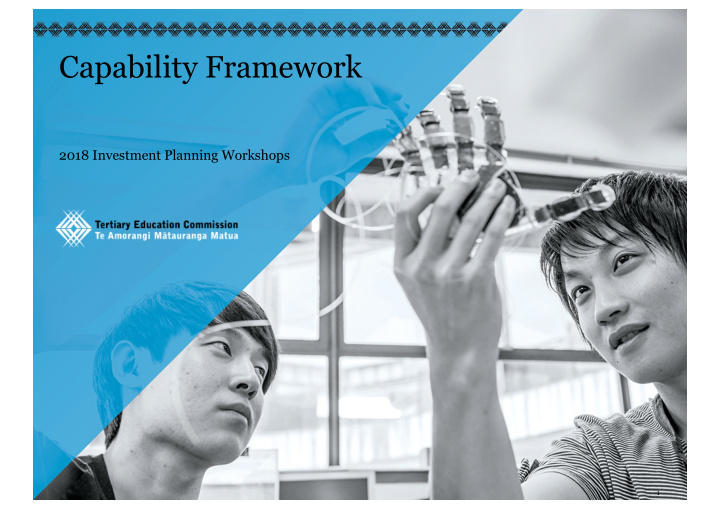



Capability Framework 2018 Investment Planning Workshops 1
Introductions Dr Stephen Marshall Associate Professor Victoria University of Wellington Stephen.Marshall@vuw.ac.nz External Expert Reference Group Professor Sally Kift Emeritus Professor Geoff Scott Deputy Vice-Chancellor University of Western Sydney (Academic) James Cook University Professor Ulf-Daniel Ehlers Vice-president Quality and Academic Affairs Baden-Wurttemberg Cooperative State University 2
Session Goals and Agenda • Why are we here? What is the TEC trying to achieve? • What is the Capability Framework? • Guidance on Capability assessments • How can the Capability Maturity Model approach to organisational improvement help TEC and TEOs work to build the capability of the tertiary system? 3
Overview of the Framework Project Ministerial objective for TEC: “supporting a self-improving, self-correcting tertiary system that responds and adapts to the changing needs of learners and employers” Project Goal: Create a framework focused on holistic improvement of TEO capability : • Support TEO-led capability improvement investments by TEC è Effective systems for learning and teaching within TEOs • Enable a diversity of responses by TEC to diverse TEO capabilities è Diversified and coordinated network of TEOs • Support greater agility and responsiveness by enabling high- capability TEOs to operate with greater latitude è Responsive, agile and flexible models of education operated by TEOs 4
Capability ≠ Quality 5
A Healthy Tertiary Education System • valued for intrinsic contributions to knowledge and extrinsic impact on broader social, economic and political goals; • goals determined by internal and external stakeholders; • public and private purposes and benefits of education balanced; • balance between individual institution interests and autonomy and the system as a whole; • status or resourcing differentials applied on objective basis; • student population is broadly representative; • sufficient funding from a diverse range of sources; • regulation supports outcomes important for external and internal stakeholders; • sufficient diversity of provision to enable the system to respond effectively to new demands and learning opportunities. Brown, R. (2011). Higher education and the market (pp. 4-5). Abingdon, UK: Routledge. N.B. Features relevant to tertiary selected from wider set 6
Future Focused Sector Capability High capability organizations have demonstrated the necessary characteristics to allow the TEC and other agencies to have a high degree of confidence that the organization can operate with a high level of autonomy. High capability organizations are trusted to manage the risks of new models of delivery or forms of provision and supported practically in their initiatives. Focus is on the conversations between the TEC and TEOs not accountability for capability, qualifications, outcomes, but on development of capability, qualifications, outcomes 7
Capability Framework Focus is on the sector rather than just individual TEOs How can TEC work with How can TEC work with the TEO as part of the the TEO as part of the investment planning investment planning process to support process to support capability development projects that increase the activities initiated by the capability and impact of TEO? the sector in new and potentially risky ways? 8
Benefits • Provide TEO’s and TEC with an integrated picture of TEO capability – that is publicly transparent, complements existing QA, financial and capital asset information and is replicable by TEOs. • Ensure that all TEO’s have the capability necessary to drive a self-improving, self-adjusting tertiary system and to incentivise investment in the critical aspects of capability necessary to drive. • Benefits that the project will enable for the sector: – Agility and innovation – Collective sense of sector capability and priorities for the future – Autonomy and a reduction in compliance burdens – Simplified and stable funding management 9
Capability Maturity Modelling 10
Capability Framework Focus Areas Governance G.1. TEO leadership is informed, guided and monitored by an active governance group. G.2. TEO plans articulate and support a differentiated and future-oriented educational mission. G.3. The TEO has a quality system informing and sustaining continuous improvement of its educational activities. G.4. The TEO benchmarks its educational activities in collaboration with other TEOs. Stakeholder engagement S.1. Key stakeholders are active partners in the oversight and guidance of TEO educational activities. S.2. Key stakeholders are actively involved in the provision of TEO educational activities. Infrastructure I.1. Infrastructure enabling the TEO’s educational activities is sufficient and aligned to the evolving and diverse learner contexts served by the TEO. I.2. Infrastructure enabling the TEO’s educational activities is sustained in collaboration with other TEOs. Support for learners progressing through the system L.1. Learners are provided with comprehensive information and support in order to select and prepare for educational activities. L.2. TEO systems actively enable learner movement between other TEOs in the sector. L.3. Learners are provided with mechanisms to demonstrate evidence of their achievements, knowledge and skills, in a range of forms, suitable for communication with key stakeholders. Support for staff D.1. Staff have substantive and systematic professional development aligned to the TEOs current and future educational activities. 11
12
“The answer to large-scale reform is not to try to emulate the characteristics of the minority who are getting somewhere under present conditions … Rather, we must change existing conditions so that it is normal and possible for a majority of people to move forward ” (Fullan, 2001, p268) 13
��� ��� ��� ��� ��� ��� ��� ��� ��� ��� ��� ��� ��� ��� ��� ��� ��� ��� ��� �� �� � �� �� �� �� �� �� �� �� �� �� �� �� �� �� �� �� ��������������������������������������������������������������������������������������� ��������������������������������������������������������������������������������������� ��������������������������������������������������������������������������������������������������������������� ����������������������������������������������������������������������������� 14
15
Recommend
More recommend